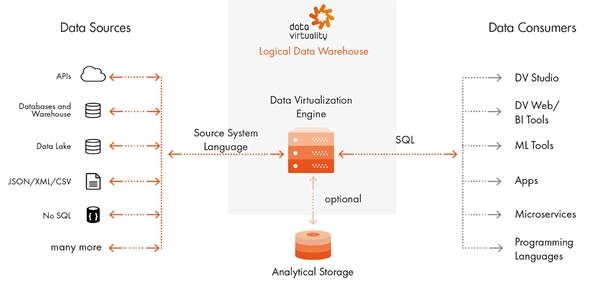
How the Logical Data Warehouse Works
The Logical Data Warehouse works by intelligently marrying two distinct technologies to create an entirely new manner of integrating data. The first technology is data federation, which connects two or more disparate databases and makes them all appear as if they were a single database. The second is analytical database management, which provides semantic business-friendly data element naming and modeling, thereby enabling flexible ingestion and modeling options.
The results are profound. Data federation alone offers flexibility but can’t scale. Analytical database management scales beautifully but is inflexible. The combination of the two enables breakaway flexibility and performance and represents an entirely new paradigm in the way we think, manage, and work with data.

For example, the Logical Data Warehouse can connect to a variety of data sources simultaneously, including classic relational databases like Oracle and MS-SQL, NoSQL databases like MongoDB or Hadoop, column stores like Vertica or SAP HANA, or web services like Google Analytics, AdWords, Facebook, Twitter, and others. Once these have been connected, the resulting integrated and overarching view of the data appears within a data analysis tool as if everything was contained in a single SQL database, accessible with a common query language. Virtually any data analysis tool currently on the market (such as Qlik, Tableau, Aqua Data, etc.) can connect, query, and analyze data via the virtual layer without the need to pull or copy data from any location.
This method offers vast new opportunities and possibilities for data exploration, data discovery, rapid prototyping, and intuitive experimentation. Business users can get results instantly and can refactor data models just as quickly. Further, building logical data views as shareable components, including common KPIs and metrics, can ensure that every report, every visualization, and every query response conforms to common corporate standards and definitions. Data Virtuality acts as a central hub connecting all systems and applications within the enterprise, enabling data exchange between systems, and ensuring that the latest data is available anywhere and anytime.
Data governance success through the Logical Data Warehouse
Data Virtuality’s Logical Data Warehouse simplifies and secures hybrid environments wherever data is stored, even when dispersed throughout various locations such as on-premises, cloud-based, third parties, or anywhere else. This greatly increases the likelihood of success for any data governance program. To promote data governance, you must promote the use of the governed data. To do this you must provide governed data assets that are so easy to use that there is no reason to search out alternative methods to source data for data consumption. By making the centrally governed data complete, accessible, and easy to find and use, it is easier for business users to adopt the use of governed data, leaving them no reason to undertake efforts to source data themselves in an ungoverned manner. This willingness and voluntary adoption will be a key driver to success for data governance and greatly increase the likelihood that data consumption is done in a
safe and accurate manner leading to accurate results.
By utilizing the Data Virtuality Logical Data Warehouse as the preferred data access gateway throughout your organization, you can centralize data governance administration. This approach simplifies the fulfillment of data protection, regulatory, and compliance requirements for GDPR, HIPAA, CCPA, BCBS239, SFTR, FRTB, Solvency II such as data lineage, responsibility and accountability, timeliness, access monitoring, system auditing,
and data classification - all while reducing the risk of a data breach.
Further, the Logical Data Warehouse adds flexibility regarding where and how you apply data governance functions to ensure aspects such as data quality and improve Master Data Management (MDM) in support of your data integrity objectives.
In our next and final blog post, we will cover a prominent use case of the Logical Data Warehouse: How it enables a flexible data supply chain for financial services.
Got interested? Visit us at Big Data Expo, booth# 64, and watch a live demo. Or schedule an appointment with one of our experts.
Reactie toevoegen